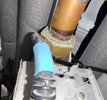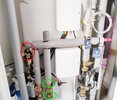Hi there,
I moved into a "second hand" new build just over a year ago. It has a large unvented Kingspan hot water cylinder in the airing cupboard.
Last year I had the boiler serviced and my plumber noticed the tundish in the airing cupboard was dripping. He order a replacement valve of some kind but whilst waiting for that to arrive, one of the compression joints in the airing cupboard started to leak. I kept a towel wrapped around it for a few days and the plumber prioritised replacing the valve and re-doing the nearby joint.
That was fine, until a few weeks later when another joint in the pipework had a very slow leak. A droplet of water would collect on the compression nut overnight, and eventually drip down the pipe work or evaporate when the heating came on. The plumber came and repaired this connection like the one previous, and all was well again.
Fast forward a few months and the tundish starts dripping again. Plumber came out and re-charged the built-in expansion vessel that is inside the cylinder. I'm not sure if homeowners are meant to do this but it looked straight-forward and he said some cylinders have instructions on the side showing how to do this.
The tundish stopped dripping, but then today (about a week or two later) I have found a different compression joint that is weeping. Unlike the previous two weeping joints, this one looks dirty and scaled up, like it has perhaps always been leaking, or has leaked in the past.
I contacted the plumber and they suggested contacting Kingspan to query the cylinder. They seem worried it might be a fault with the cylinder and the endless leaks are a symptom of something else. I did this and Kingspan said it's just wear and tear on the connections which need tightening periodically.
Personally I think it is just a shoddy new build install and the contractor didn't do up the connections properly, or perhaps over tightened them, or whatever.
Just looking for a second opinion really.
Thanks,
I moved into a "second hand" new build just over a year ago. It has a large unvented Kingspan hot water cylinder in the airing cupboard.
Last year I had the boiler serviced and my plumber noticed the tundish in the airing cupboard was dripping. He order a replacement valve of some kind but whilst waiting for that to arrive, one of the compression joints in the airing cupboard started to leak. I kept a towel wrapped around it for a few days and the plumber prioritised replacing the valve and re-doing the nearby joint.
That was fine, until a few weeks later when another joint in the pipework had a very slow leak. A droplet of water would collect on the compression nut overnight, and eventually drip down the pipe work or evaporate when the heating came on. The plumber came and repaired this connection like the one previous, and all was well again.
Fast forward a few months and the tundish starts dripping again. Plumber came out and re-charged the built-in expansion vessel that is inside the cylinder. I'm not sure if homeowners are meant to do this but it looked straight-forward and he said some cylinders have instructions on the side showing how to do this.
The tundish stopped dripping, but then today (about a week or two later) I have found a different compression joint that is weeping. Unlike the previous two weeping joints, this one looks dirty and scaled up, like it has perhaps always been leaking, or has leaked in the past.
I contacted the plumber and they suggested contacting Kingspan to query the cylinder. They seem worried it might be a fault with the cylinder and the endless leaks are a symptom of something else. I did this and Kingspan said it's just wear and tear on the connections which need tightening periodically.
Personally I think it is just a shoddy new build install and the contractor didn't do up the connections properly, or perhaps over tightened them, or whatever.
Just looking for a second opinion really.
Thanks,
Last edited:




